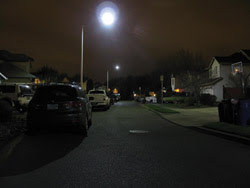Most streetlights in the US are high-pressure sodium, but the many advantages of LEDs are pushing municipalities to make the switch – or at least to think about it. Because it is such a big chunk of change to lay out at the start, the US Department of Energy (DoE) is forming a Municipal Solid-State Street Lighting (SSL) Consortium to provide a forum for sharing information, knowledge and experience.
Membership is open to municipalities, utilities and energy-efficiency organizations. As the American Recovery and Reinvestment Act funding reaches towns planning these upgrades, the DoE is inundated with requests for demonstrations, explanations and comparisons. The consortium helps municipalities gain insight from experts on SSL issues and share information with others on pilot projects. Some of the SSL issues include lumen maintenance, product reliability and optical performance.

A neighborhood in Portland, Ore., switched to LED streetlights to save energy and maintenance costs. Courtesy of DoE Pacific Northwest National Laboratory.
“Basically,” noted Marc Ledbetter, program manager of Emerging Technologies at the DoE’s Pacific Northwest National Laboratory in Richland, Wash., “the idea is to help cities avoid mistakes that some will inevitably make.” In addition, a greater body of field test data will be collected through information sharing and demonstrations of installations. Common evaluation methods will be used, so those interested in solid-state streetlighting can make valid comparisons across a range of conditions, including climate and cost.
The consortium is open to all municipalities. One city implementing a large-scale switch to SSL is Anchorage, Alaska, which, at the time of writing, had achieved one-third of its goal toward changing all city-owned streetlights to LEDs. Anchorage is part of the Raleigh, N.C.-based Cree LED City initiative.
The streetlights are made by BetaLED of Sturtevant, Wis., with XLamp LEDs from Cree Inc. The upfront cost of $2.2 million is expected to be recovered in seven years. The city expects to use half the energy with the LED lamps, saving approximately $360,000 annually in energy costs. LED lamps also are expected to last 50,000 h, as compared with 24,000 for high-pressure sodium (see “State of the Streetlight,” December 2008 Photonics Spectra, p. 38), saving maintenance costs as well.
Other cities with pilot projects in place include Los Angeles, San Francisco and Oakland, Calif. Although manufacturers will not be part of the consortium, the DoE expects to call on them to present information at meetings.
More information can be found on the DoE’s solid-state-lighting Web site.